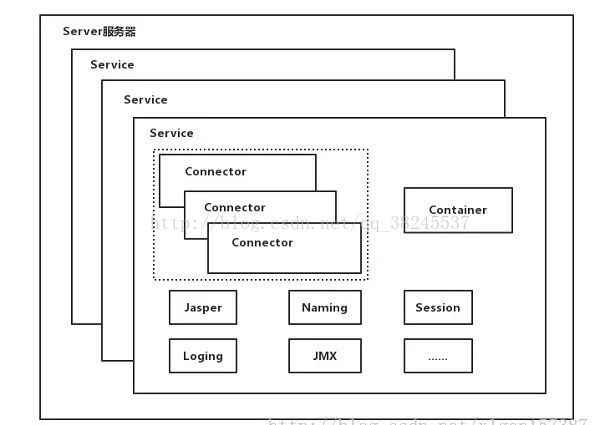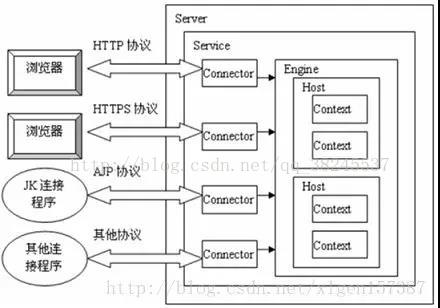SpringBoot内置tomcat启动原理详解
前言
不得不说SpringBoot的开发者是在为大众程序猿谋福利,把大家都惯成了懒汉,xml不配置了,连tomcat也懒的配置了,典型的一键启动系统,那么tomcat在springboot是怎么启动的呢?
内置tomcat
开发阶段对我们来说使用内置的tomcat是非常够用了,当然也可以使用jetty。
<dependency> <groupId>org.springframework.boot</groupId> <artifactId>spring-boot-starter-web</artifactId> <version>2.1.6.RELEASE</version> </dependency>
@SpringBootApplication
public class MySpringbootTomcatStarter{
public static void main(String[] args) {
Long time=System.currentTimeMillis();
SpringApplication.run(MySpringbootTomcatStarter.class);
System.out.println("===应用启动耗时:"+(System.currentTimeMillis()-time)+"===");
}
}
这里是main函数入口,两句代码最耀眼,分别是SpringBootApplication注解和SpringApplication.run()方法。
发布生产
发布的时候,目前大多数的做法还是排除内置的tomcat,打瓦包(war)然后部署在生产的tomcat中,好吧,那打包的时候应该怎么处理?
<dependency>
<groupId>org.springframework.boot</groupId>
<artifactId>spring-boot-starter-web</artifactId>
<!-- 移除嵌入式tomcat插件 -->
<exclusions>
<exclusion>
<groupId>org.springframework.boot</groupId>
<artifactId>spring-boot-starter-tomcat</artifactId>
</exclusion>
</exclusions>
</dependency>
<!--添加servlet-api依赖--->
<dependency>
<groupId>javax.servlet</groupId>
<artifactId>javax.servlet-api</artifactId>
<version>3.1.0</version>
<scope>provided</scope>
</dependency>
更新main函数,主要是继承SpringBootServletInitializer,并重写configure()方法。
@SpringBootApplication
public class MySpringbootTomcatStarter extends SpringBootServletInitializer {
public static void main(String[] args) {
Long time=System.currentTimeMillis();
SpringApplication.run(MySpringbootTomcatStarter.class);
System.out.println("===应用启动耗时:"+(System.currentTimeMillis()-time)+"===");
}
@Override
protected SpringApplicationBuilder configure(SpringApplicationBuilder builder) {
return builder.sources(this.getClass());
}
}
从main函数说起
public static ConfigurableApplicationContext run(Class<?> primarySource, String... args) {
return run(new Class[]{primarySource}, args);
}
--这里run方法返回的是ConfigurableApplicationContext
public static ConfigurableApplicationContext run(Class<?>[] primarySources, String[] args) {
return (new SpringApplication(primarySources)).run(args);
}
public ConfigurableApplicationContext run(String... args) {
ConfigurableApplicationContext context = null;
Collection<SpringBootExceptionReporter> exceptionReporters = new ArrayList();
this.configureHeadlessProperty();
SpringApplicationRunListeners listeners = this.getRunListeners(args);
listeners.starting();
Collection exceptionReporters;
try {
ApplicationArguments applicationArguments = new DefaultApplicationArguments(args);
ConfigurableEnvironment environment = this.prepareEnvironment(listeners, applicationArguments);
this.configureIgnoreBeanInfo(environment);
//打印banner,这里你可以自己涂鸦一下,换成自己项目的logo
Banner printedBanner = this.printBanner(environment);
//创建应用上下文
context = this.createApplicationContext();
exceptionReporters = this.getSpringFactoriesInstances(SpringBootExceptionReporter.class, new Class[]{ConfigurableApplicationContext.class}, context);
//预处理上下文
this.prepareContext(context, environment, listeners, applicationArguments, printedBanner);
//刷新上下文
this.refreshContext(context);
//再刷新上下文
this.afterRefresh(context, applicationArguments);
listeners.started(context);
this.callRunners(context, applicationArguments);
} catch (Throwable var10) {
}
try {
listeners.running(context);
return context;
} catch (Throwable var9) {
}
}
既然我们想知道tomcat在SpringBoot中是怎么启动的,那么run方法中,重点关注创建应用上下文(createApplicationContext)和刷新上下文(refreshContext)。
创建上下文
//创建上下文
protected ConfigurableApplicationContext createApplicationContext() {
Class<?> contextClass = this.applicationContextClass;
if (contextClass == null) {
try {
switch(this.webApplicationType) {
case SERVLET:
//创建AnnotationConfigServletWebServerApplicationContext
contextClass = Class.forName("org.springframework.boot.web.servlet.context.AnnotationConfigServletWebServerApplicationContext");
break;
case REACTIVE:
contextClass = Class.forName("org.springframework.boot.web.reactive.context.AnnotationConfigReactiveWebServerApplicationContext");
break;
default:
contextClass = Class.forName("org.springframework.context.annotation.AnnotationConfigApplicationContext");
}
} catch (ClassNotFoundException var3) {
throw new IllegalStateException("Unable create a default ApplicationContext, please specify an ApplicationContextClass", var3);
}
}
return (ConfigurableApplicationContext)BeanUtils.instantiateClass(contextClass);
}
这里会创建AnnotationConfigServletWebServerApplicationContext类。
而AnnotationConfigServletWebServerApplicationContext类继承了ServletWebServerApplicationContext,而这个类是最终集成了AbstractApplicationContext。
刷新上下文
//SpringApplication.java
//刷新上下文
private void refreshContext(ConfigurableApplicationContext context) {
this.refresh(context);
if (this.registerShutdownHook) {
try {
context.registerShutdownHook();
} catch (AccessControlException var3) {
}
}
}
//这里直接调用最终父类AbstractApplicationContext.refresh()方法
protected void refresh(ApplicationContext applicationContext) {
((AbstractApplicationContext)applicationContext).refresh();
}
//AbstractApplicationContext.java
public void refresh() throws BeansException, IllegalStateException {
synchronized(this.startupShutdownMonitor) {
this.prepareRefresh();
ConfigurableListableBeanFactory beanFactory = this.obtainFreshBeanFactory();
this.prepareBeanFactory(beanFactory);
try {
this.postProcessBeanFactory(beanFactory);
this.invokeBeanFactoryPostProcessors(beanFactory);
this.registerBeanPostProcessors(beanFactory);
this.initMessageSource();
this.initApplicationEventMulticaster();
//调用各个子类的onRefresh()方法,也就说这里要回到子类:ServletWebServerApplicationContext,调用该类的onRefresh()方法
this.onRefresh();
this.registerListeners();
this.finishBeanFactoryInitialization(beanFactory);
this.finishRefresh();
} catch (BeansException var9) {
this.destroyBeans();
this.cancelRefresh(var9);
throw var9;
} finally {
this.resetCommonCaches();
}
}
}
//ServletWebServerApplicationContext.java
//在这个方法里看到了熟悉的面孔,this.createWebServer,神秘的面纱就要揭开了。
protected void onRefresh() {
super.onRefresh();
try {
this.createWebServer();
} catch (Throwable var2) {
}
}
//ServletWebServerApplicationContext.java
//这里是创建webServer,但是还没有启动tomcat,这里是通过ServletWebServerFactory创建,那么接着看下ServletWebServerFactory
private void createWebServer() {
WebServer webServer = this.webServer;
ServletContext servletContext = this.getServletContext();
if (webServer == null && servletContext == null) {
ServletWebServerFactory factory = this.getWebServerFactory();
this.webServer = factory.getWebServer(new ServletContextInitializer[]{this.getSelfInitializer()});
} else if (servletContext != null) {
try {
this.getSelfInitializer().onStartup(servletContext);
} catch (ServletException var4) {
}
}
this.initPropertySources();
}
//接口
public interface ServletWebServerFactory {
WebServer getWebServer(ServletContextInitializer... initializers);
}
//实现
AbstractServletWebServerFactory
JettyServletWebServerFactory
TomcatServletWebServerFactory
UndertowServletWebServerFactory
这里ServletWebServerFactory接口有4个实现类

而其中我们常用的有两个:TomcatServletWebServerFactory和JettyServletWebServerFactory。
//TomcatServletWebServerFactory.java
//这里我们使用的tomcat,所以我们查看TomcatServletWebServerFactory。到这里总算是看到了tomcat的踪迹。
@Override
public WebServer getWebServer(ServletContextInitializer... initializers) {
Tomcat tomcat = new Tomcat();
File baseDir = (this.baseDirectory != null) ? this.baseDirectory : createTempDir("tomcat");
tomcat.setBaseDir(baseDir.getAbsolutePath());
//创建Connector对象
Connector connector = new Connector(this.protocol);
tomcat.getService().addConnector(connector);
customizeConnector(connector);
tomcat.setConnector(connector);
tomcat.getHost().setAutoDeploy(false);
configureEngine(tomcat.getEngine());
for (Connector additionalConnector : this.additionalTomcatConnectors) {
tomcat.getService().addConnector(additionalConnector);
}
prepareContext(tomcat.getHost(), initializers);
return getTomcatWebServer(tomcat);
}
protected TomcatWebServer getTomcatWebServer(Tomcat tomcat) {
return new TomcatWebServer(tomcat, getPort() >= 0);
}
//Tomcat.java
//返回Engine容器,看到这里,如果熟悉tomcat源码的话,对engine不会感到陌生。
public Engine getEngine() {
Service service = getServer().findServices()[0];
if (service.getContainer() != null) {
return service.getContainer();
}
Engine engine = new StandardEngine();
engine.setName( "Tomcat" );
engine.setDefaultHost(hostname);
engine.setRealm(createDefaultRealm());
service.setContainer(engine);
return engine;
}
//Engine是最高级别容器,Host是Engine的子容器,Context是Host的子容器,Wrapper是Context的子容器
getWebServer这个方法创建了Tomcat对象,并且做了两件重要的事情:把Connector对象添加到tomcat中,configureEngine(tomcat.getEngine());
getWebServer方法返回的是TomcatWebServer。
//TomcatWebServer.java
//这里调用构造函数实例化TomcatWebServer
public TomcatWebServer(Tomcat tomcat, boolean autoStart) {
Assert.notNull(tomcat, "Tomcat Server must not be null");
this.tomcat = tomcat;
this.autoStart = autoStart;
initialize();
}
private void initialize() throws WebServerException {
//在控制台会看到这句日志
logger.info("Tomcat initialized with port(s): " + getPortsDescription(false));
synchronized (this.monitor) {
try {
addInstanceIdToEngineName();
Context context = findContext();
context.addLifecycleListener((event) -> {
if (context.equals(event.getSource()) && Lifecycle.START_EVENT.equals(event.getType())) {
removeServiceConnectors();
}
});
//===启动tomcat服务===
this.tomcat.start();
rethrowDeferredStartupExceptions();
try {
ContextBindings.bindClassLoader(context, context.getNamingToken(), getClass().getClassLoader());
}
catch (NamingException ex) {
}
//开启阻塞非守护进程
startDaemonAwaitThread();
}
catch (Exception ex) {
stopSilently();
destroySilently();
throw new WebServerException("Unable to start embedded Tomcat", ex);
}
}
}
//Tomcat.java
public void start() throws LifecycleException {
getServer();
server.start();
}
//这里server.start又会回到TomcatWebServer的
public void stop() throws LifecycleException {
getServer();
server.stop();
}
//TomcatWebServer.java
//启动tomcat服务
@Override
public void start() throws WebServerException {
synchronized (this.monitor) {
if (this.started) {
return;
}
try {
addPreviouslyRemovedConnectors();
Connector connector = this.tomcat.getConnector();
if (connector != null && this.autoStart) {
performDeferredLoadOnStartup();
}
checkThatConnectorsHaveStarted();
this.started = true;
//在控制台打印这句日志,如果在yml设置了上下文,这里会打印
logger.info("Tomcat started on port(s): " + getPortsDescription(true) + " with context path '"
+ getContextPath() + "'");
}
catch (ConnectorStartFailedException ex) {
stopSilently();
throw ex;
}
catch (Exception ex) {
throw new WebServerException("Unable to start embedded Tomcat server", ex);
}
finally {
Context context = findContext();
ContextBindings.unbindClassLoader(context, context.getNamingToken(), getClass().getClassLoader());
}
}
}
//关闭tomcat服务
@Override
public void stop() throws WebServerException {
synchronized (this.monitor) {
boolean wasStarted = this.started;
try {
this.started = false;
try {
stopTomcat();
this.tomcat.destroy();
}
catch (LifecycleException ex) {
}
}
catch (Exception ex) {
throw new WebServerException("Unable to stop embedded Tomcat", ex);
}
finally {
if (wasStarted) {
containerCounter.decrementAndGet();
}
}
}
}
附:tomcat顶层结构图

tomcat最顶层容器是Server,代表着整个服务器,一个Server包含多个Service。从上图可以看除Service主要包括多个Connector和一个Container。Connector用来处理连接相关的事情,并提供Socket到Request和Response相关转化。Container用于封装和管理Servlet,以及处理具体的Request请求。那么上文提到的Engine>Host>Context>Wrapper容器又是怎么回事呢? 我们来看下图:

综上所述,一个tomcat只包含一个Server,一个Server可以包含多个Service,一个Service只有一个Container,但有多个Connector,这样一个服务可以处理多个连接。
多个Connector和一个Container就形成了一个Service,有了Service就可以对外提供服务了,但是Service要提供服务又必须提供一个宿主环境,那就非Server莫属了,所以整个tomcat的声明周期都由Server控制。
总结
SpringBoot的启动主要是通过实例化SpringApplication来启动的,启动过程主要做了以下几件事情:配置属性、获取监听器,发布应用开始启动事件初、始化输入参数、配置环境,输出banner、创建上下文、预处理上下文、刷新上下文、再刷新上下文、发布应用已经启动事件、发布应用启动完成事件。在SpringBoot中启动tomcat的工作在刷新上下这一步。而tomcat的启动主要是实例化两个组件:Connector、Container,一个tomcat实例就是一个Server,一个Server包含多个Service,也就是多个应用程序,每个Service包含多个Connector和一个Container,而一个Container下又包含多个子容器。
到此这篇关于SpringBoot内置tomcat启动原理详解的文章就介绍到这了,更多相关SpringBoot内置tomcat启动内容请搜索猪先飞以前的文章或继续浏览下面的相关文章希望大家以后多多支持猪先飞!
相关文章
- 这篇文章主要介绍了Tomcat配置及如何在Eclipse中启动,本文给大家介绍的非常详细,对大家的学习或工作具有一定的参考借鉴价值,需要的朋友可以参考下...2021-02-04
解决springboot使用logback日志出现LOG_PATH_IS_UNDEFINED文件夹的问题
这篇文章主要介绍了解决springboot使用logback日志出现LOG_PATH_IS_UNDEFINED文件夹的问题,文中通过示例代码介绍的非常详细,对大家的学习或者工作具有一定的参考学习价值,需要的朋友们下面随着小编来一起学习学习吧...2021-04-28- 这篇文章主要为大家详细介绍了SpringBoot实现excel文件生成和下载,文中示例代码介绍的非常详细,具有一定的参考价值,感兴趣的小伙伴们可以参考一下...2021-02-09
- 这篇文章主要介绍了详解springBoot启动时找不到或无法加载主类解决办法,文中通过示例代码介绍的非常详细,对大家的学习或者工作具有一定的参考学习价值,需要的朋友们下面随着小编来一起学习学习吧...2020-09-16
php-fpm 启动报please specify user and group other than root, pool ‘default’
本文章来给大家介绍关于php-fpm 启动报please specify user and group other than root, pool ‘default’的解决办法。 安装PHP ,配置fpm 成功后启动发现报错: St...2016-11-25- 这篇文章主要介绍了IDEA 2021.2 启动报错及激活教程,文章开头给大家介绍了idea2021最新激活方法,关于idea2021启动报错的问题小编也给大家介绍的非常详细,需要的朋友可以参考下...2021-10-15
- 这篇文章主要介绍了SpringBoot集成Redis实现消息队列的方法,文中通过示例代码介绍的非常详细,对大家的学习或者工作具有一定的参考学习价值,需要的朋友们下面随着小编来一起学习学习吧...2021-02-10
- 在程序执行中会遇到启动本软件的exe问,或者启用其它的exe文件,已达到执行某些操作的作用。下面是两种最常见的启动exe文件。...2020-06-25
- 这篇文章主要介绍了解决Springboot get请求是参数过长的情况,具有很好的参考价值,希望对大家有所帮助。一起跟随小编过来看看吧...2020-09-17
- 这篇文章主要介绍了Jrebel启动失败解决方案详解,文中通过示例代码介绍的非常详细,对大家的学习或者工作具有一定的参考学习价值,需要的朋友可以参考下...2020-07-07
Spring Boot项目@RestController使用重定向redirect方式
这篇文章主要介绍了Spring Boot项目@RestController使用重定向redirect方式,具有很好的参考价值,希望对大家有所帮助。如有错误或未考虑完全的地方,望不吝赐教...2021-09-02- 这篇文章主要介绍了Springboot+TCP监听服务器搭建过程,本文通过图文并茂的形式给大家介绍的非常详细,对大家的学习或工作具有一定的参考借鉴价值,需要的朋友可以参考下...2020-10-28
- 这篇文章主要介绍了springBoot 项目排除数据库启动方式,具有很好的参考价值,希望对大家有所帮助。如有错误或未考虑完全的地方,望不吝赐教...2021-09-10
- centos6.2,停止mysqld然后修改/etc/my.cnf datadir的位置,启动mysqld提示FAILED,查看日志 复制代码 代码如下: 120609 11:31:31 mysqld_safe mysqld from pid file /var/run/mysqld/mysqld.pid ended 120609 11:35:12 my...2015-03-15
- 这篇文章主要介绍了SpringBoot接口接收json参数解析,具有很好的参考价值,希望对大家有所帮助。如有错误或未考虑完全的地方,望不吝赐教...2021-10-19
详解SpringBoot之访问静态资源(webapp...)
这篇文章主要介绍了详解SpringBoot之访问静态资源(webapp...),文中通过示例代码介绍的非常详细,对大家的学习或者工作具有一定的参考学习价值,需要的朋友们下面随着小编来一起学习学习吧...2020-09-14springboot中使用@Transactional注解事物不生效的坑
这篇文章主要介绍了springboot中使用@Transactional注解事物不生效的原因,文中通过示例代码介绍的非常详细,对大家的学习或者工作具有一定的参考学习价值,需要的朋友们下面随着小编来一起学习学习吧...2021-01-26Jenkins+tomcat自动发布的热部署/重启及遇到的问题解决办法(推荐)
这篇文章主要介绍了Jenkins+tomcat自动发布的热部署/重启及遇到的问题解决办法,本文给大家介绍的非常详细,对大家的学习或工作具有一定的参考借鉴价值,需要的朋友可以参考下...2020-07-10- 过滤器Filter是定义于tomcat的servlet-api.jar中的一个接口,接口路径为javax.servlet.Filter。tomcat过滤器采用了典型的过滤器设计模式,过滤器链FilterChain由tomcat维持,链条是可以支持多个过滤器的...2021-06-26
- 这篇文章主要介绍了springboot多模块包扫描问题的解决方法,文中通过示例代码介绍的非常详细,对大家的学习或者工作具有一定的参考学习价值,需要的朋友们下面随着小编来一起学习学习吧...2020-09-16
